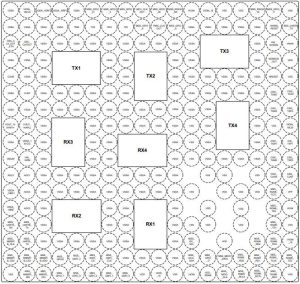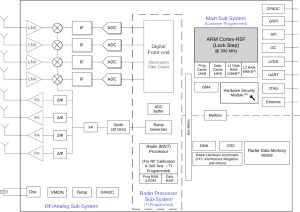Called AWR2544 and made on 45 nm RFCMOS, it is aimed, for example, at vehicles with a radar at each corner that use ‘satellite’ rather than the more locally demanding ‘edge’ vehicle architecture, according to the company.
With edge architecture, the radar will perform Doppler and angle fast FFTs, along with subsequent high-level algorithms for object detection, classification and tracking – sending this completely processed data to the central automated driving (ADAS) computer.
“In satellite architectures, radar sensors output semi-processed data to a central processor for ADAS decision-making,” said TI.
As such, a radar aimed at satellite architectures does not need as much processing power as one for an edge architecture.
“AWR2544 features an integrated 77GHz transceiver with four transmitters and four receivers,” said TI. “It also includes a cost-optimised radar processing accelerator and a 1Gbit/s Ethernet interface to generate and stream range FFT-compressed data. The device is ASIL (automotive safety integrity level) B-capable.”
Its FMCW transceiver can work across 76 to 81GHz and includes PLL, VCO, mixer and base-band ADC, plus a front-end controller to configure and monitor these. A user-programmable Arm Cortex-R5F is provided for control and automotive interface applications, backed by a hardware accelerator which can handle FFT, scaling and compression.
Security processing is handled by an on-board Arm Cortex-M4 MCU and associated infrastructure
 Launch-on-package in 12.4 x 12mm FCCSP version Grounded pins (‘VSSA’) surrounding the eight launch pads are required for the scheme to work.
Launch-on-package in 12.4 x 12mm FCCSP version Grounded pins (‘VSSA’) surrounding the eight launch pads are required for the scheme to work.
An unusual feature of the radar IC package is that it has built-in local radiating elements – dubbed ‘launch-on-package’ (‘LOP’) by TI – designed to interface to the system antenna through waveguides within the PCB.
“LOP helps reduce the size of the sensor by as much as 30% by mounting a 3D waveguide antenna on the opposite side of the printed circuit board,” it said. “LOP also enables sensor ranges to extend beyond 200m with a single chip.”
Software designs, software drivers, sample configurations, API guides and user documentation is available.

